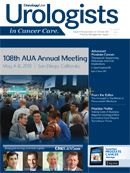Publication
Article
Oncology Live Urologists in Cancer Care®
Lack of PSA Screening Leads to Poor Prognosis in Prostate Cancer
Author(s):
Prostate cancer prognosis remains poor for patients who have a prostate-specific antigen level ≥100 ng/mL at discovery, a review of cancer registry data showed.
Jeffrey H. Reese, MD
Prostate cancer prognosis remains poor for patients who have a prostate-specific antigen (PSA) level ≥100 ng/mL at discovery, a review of cancer registry data showed.
The patients had a median survival of 18 months, and fewer than 10% lived beyond 3 years. How far the PSA level exceeded 100 ng/mL at presentation, Gleason score, race, and bone involvement at diagnosis did not significantly influence survival odds.
Men with PSA levels ≥100 ng/mL at diagnosis have high-volume tumors that generate high production of PSA, according to Jeffrey H. Reese, MD, a urologist at Santa Clara Valley Medical Center (SCVMC) in Calfornia, who presented the results of the study at the Annual Meeting of the American Urological Association. Screening PSA tests would be expected to detect such tumors at an earlier stage of development, Reese said.
“Our study confirms poor survival and significant morbidity in men initially presenting with PSA ≥100 ng/mL,” he said. “It stresses the vital role of PSA and the need for improved access to screening, which would have detected these cancers at earlier stages.”
Reese added that many of the patients in the study may have gone without PSA screening because they were underinsured.
He said that the 71 patients in the study accounted for 14.4% of all new prostate cancer diagnoses at the medical center between 1998 and 2008, or one of every seven patients, a subgroup that included an overrepresentation of underinsured men.
“Our underinsured patient population presented with advanced prostate cancer at a rate of at least 3.6 times the national average of 4%, and survival was substantially less than the national 71% 5-year survival for metastatic disease,” Reese said.
To examine the potential consequences of not screening for prostate cancer, investigators searched medical records of all men with newly diagnosed prostate cancer from 1998 to 2008 at SCVMC, a county hospital that serves a large population of uninsured and underinsured patients. The search focused on men who had PSA levels ≥100 ng/mL at diagnosis.
The 71 patients identified by the search had no history of screening PSA tests at the medical center prior to diagnosis of prostate cancer. Men younger than age 60 years accounted for the largest proportion of the patients (26; 36.6%), followed by ages 61-70 (19; 26.4%), ages 71-80 (15; 20.8%), and older than age 80 (11; 15.3%).
About 60% of the patients were either Asian (n=20) or Hispanic (n=22), and Caucasians accounted for 18.3% (13/71).
Gleason grade was available for 47 patients and showed that only two patients had Gleason grade ≤6 tumors. Gleason 9 accounted for the largest proportion (21; 44.7%). The median PSA at presentation was 399 ng/mL, including 26 (36.6%) men with PSA levels of 201-600 ng/mL and 19 (26.8%) with levels above 1000 ng/mL.
Mean survival was 22.4 months, but only seven men (9.7%) lived longer than 3 years. In a multivariate analysis, the only predictors of improved survival were a posttreatment PSA nadir <1 ng/mL (P=.02) and age <60 at diagnosis (P<.001).
Following treatment, the patients had a high morbidity burden that included chronic pain in 48 men, anemia in 57, hospitalization in 46, chronic catheterization in 21, gross hematuria in 16, spinal cord compression in 14, and pathologic fractures in 12.
“Despite modern therapy, survival is poor for advanced prostate cancer associated with PSA levels of 100 ng/mL or greater,” Reese concluded. “In the absence of screening, 14% of prostate cancer patients are diagnosed with PSA levels of 100 ng/mL or greater at presentation. Our results suggest a role for continued PSA screening.”
Adams W, Elliott C, Reese J. The fate of men presenting with PSA over 100 ng/mL: What happens when we do not screen for prostate cancer? Presented at: Annual Meeting of the American Urological Association; May 4-8, 2013; San Diego, CA. Abstract 1484.










